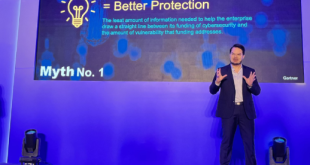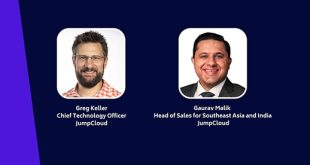The Internet of Things (IoT) is enabling us, individuals, to use our personal things, home appliances and other physical objects in ways we never imagined. It’s generating a constant stream of new data that is sparking revolutionary insights and game-changing value for customers.
As companies explore opportunities in the rapidly evolving IoT space, they need an expert to help them understand their options, reduce risks and provide access to resources to make their IoT vision a reality. Avnet is one such company that aligns customers with capabilities and services that address the entire range of IoT complexities, such as sensor design and development, infrastructure and gateway solutions, connectivity options, cloud IoT platforms, and global inventory management. In an exclusive interview with itVARnews, Max Chan, Vice President, Global Information Solutions, Avnet Technology Solutions Asia Pacific and Naresh Desai, Vice President, Avnet Technology Solutions, India informs that they have specialist knowledge of vertical markets and on-the-ground expertise across every part of the IoT supply chain. Read More…
Internet of Things is the next technology to hit the B2C market. How do you think companies in India should take it to the consumer base?
Max Chan

The Internet of Things (IoT) is a network of devices with embedded technology that enable the transfer of data via the internet. This is slated to become a key enabling technology for digital businesses. According to Gartner, in 2015, 4.9 billion connected things were in use – a figure that they predict will rise to 25 billion by 2020. Meanwhile, research firm IDC forecasts IoT growth in the Asia Pacific excluding Japan (APeJ) region to hit 8.6 billion devices during that same time period. This is due to rapid urbanisation as countries in the region welcome foreign investment, leading the way to technology and device proliferation. Growth in the manufacturing sector and the ease in connecting them to the Internet (essentially, becoming the “things” in the Internet of Things) is also a strong factor, particularly in countries that hold manufacturing as part of their economy, which in this case, is most of South Asia.
According to IDC, global IoT spending will grow from US$655.8 billion in 2014 to US$1.7 trillion in 2020, with a CAGR of 16.9%. To increase its development and deployment, Avnet is currently working with IBM to create new revenue streams and operational efficiencies, which will help our consumers capitalise on the IoT market’s growth.
Naresh Desai
India holds a lot of potential in terms of IoT and data analytics adoption and usage. A TechSci Research report predicts that IoT market in India will grow at a CAGR of more than 28 percent during 2015 – 2020. To properly bring the IoT to the Indian consumer base, there needs to be a competent supplier, who is in a position to anticipate and understand what the consumer needs, both today and in the future. They will then be able to transform technology products into business solutions which can be used to their fullest potential.
What challenges do you foresee if companies do not keep up with data analytics trends?
Max Chan
Data is useless unless it is understood and acted upon. The role of data scientists and analysts within an organisation is to work with the data they have, and turn it into business intelligence and insights, which can then be used by higher management and decision-makers. Companies that do not keep up with data analytics trends stand to lose their competitiveness in the field, as well as some of the ability to react to changing trends in the market.
Data analytics solutions are readily available in the market and the onus is really on the enterprises to harness them for their benefit. Many industries are readily adopting them, especially those from the retail, buildings and utilities sectors. It is getting harder for these sectors to respond in real-time to either their customers or to the public, and as such they need to get closer to their consumers, analysing factors such as their preferences and buying power, to stay ahead of competition.
Storage is fast becoming a challenge. Do you think the cloud is enough?
Max Chan
Avnet is currently working with the world’s leading suppliers of storage and cloud solutions. We are also making strategic investments into areas such as big data, security and cloud as these are areas which will see high growth and demand in the coming year. We also recognise the importance of achieving organic growth in these segments as a priority.
In order to enable our partners to capitalise on high-growth areas, Avnet has expanded our Avnet Academy program to include technical education and training around the cloud, ranging from basic essentials of cloud application development to immersive development experiences. This program is free for our business partners to access at any time to further their expertise in the cloud.
So to answer your question, yes, storage off the cloud is becoming a challenge, but because of the latest initiatives that we, have put into play around it, cloud can now become the de-facto method of storage that our partners can utilise.
Do you think the Asian governments are doing enough to utilise IoT and M2M for providing better, clean, more optimised lifestyles to citizens?
Max Chan
Many governments, especially those in Asia, recognise these trends are the way forward, and are doing their best to help both individuals and organisations in their adoption. In Singapore, for instance, there is the Smart Nation initiative, which has IoT, big data and analytics, M2M and other ICM technologies as its basis.
Naresh Desai

In India, the government is slowly but surely realizing the importance of implementation of IoT. According to the Ministry of Communication and Information Technology Government of India policy, The Indian Government’s plan of developing 100 smart cities in the country, for which Rs. 7,060 crores has been allocated in the current budget could lead to a massive and quick expansion of IoT in the country. Also, the launch of the Digital India Program of the Government, which aims at ‘transforming India into digital empowered society and knowledge economy’ will provide the required impetus for development of the IoT industry in the country. We see that the government sector in India has expeditiously progressed in certain key areas that are paving the way for IoT acceptance and opening up new business opportunities for IoT solution businesses.
Geographically, in terms of adoption, Asia Pacific is far ahead of the pack, with Singapore, Hong Kong and Australia being the leaders, and China and India close behind.
Security is a huge concern with growing data generation and an increasing portion of it becoming business critical. How do you think enterprises can cope with this threat?
Max Chan
We have definitely observed increasing awareness around cybersecurity. This results largely from the number of cyber-attacks that have been increasing consistently, leading to a corresponding increase in demand for cyber-insurance. Avnet has formed partnerships with well-known security firms to strengthen our security portfolio for our partners – in this case, organisations and enterprises.
Enterprises, also need to be aware of how they can better protect themselves and their clientele. They can do this through education and training, which is part of the resources we offer through Avnet Academy, as well as setting up a standard operating procedures for what to do should a cyberattack occur. Most importantly, enterprises need to educate their employees, as most cyber-attacks occur through employees inadvertently leaving gateways open for hackers to exploit.
Another helpful factor is the knowledge and expertise of the distributor and vendor. As a distributor, Avnet is aware of the needs of our clients and are able to devise the best possible security solution to prevent or mitigate cyberattacks. We also work closely with our clients to be able them to anticipate, as much as possible, where future attacks could strike, as well as other possible problem areas in existing infrastructure and solutions.
In India, the utilities industry is only partly privatised. What steps would you recommend for utilisation of IoT for optimising our resources in the utilities sector? How can enterprises help?
Naresh Desai
The Internet of Things is well and truly here in India and is providing great expectations around benefits to businesses including new business opportunities for IoT solution providers. Though there is large-scale awareness of the benefits of IoT in the larger business environment, adoption across smaller sectors is still quite slow. This is mostly due to security concerns. IoT solution providers must address these concerns and educate end-user organizations on the greater benefits of IoT. India’s privatization initiatives and newer regulations have opened up the market to serious competition in terms of adopting IoT. According to a recent report by Deloitte, energy and utility are estimated to drive future market growth of Machine to Machine (M2M). This is a result of the Indian government’s important initiative to deploy smart energy meters. Energy and utilities application markets are expected to grow at a CAGR of 38.12 per cent from the period of 2011-2016. Many positive case studies are now emerging across industry sectors of successful implementation of (IoT) technologies. These projects are creating new efficiencies, a competitive edge, cost savings and revenues, and demonstrating that the IoT is here to stay.
 Latest Technology News Today – Get Latest Information Technology Updates and Services Latest Technology News Today – Get Latest Information Technology Updates and Services
Latest Technology News Today – Get Latest Information Technology Updates and Services Latest Technology News Today – Get Latest Information Technology Updates and Services 








